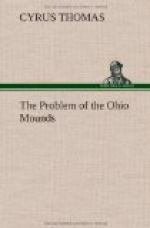Jones says: [Footnote: Antiq. So. Indians, p. 400.]
It has been more than hinted at by at least one person whose statement is entitled to every belief, that among the Cherokees dwelling in the mountains there existed certain artists whose professed occupation was the manufacture of stone pipes, which were by them transported to the coast and there bartered away for articles of use and ornament foreign to and highly esteemed among the members of their own tribe.
This not only strengthens the conclusions drawn from the presence of such pipes in the mounds alluded to, but may also assist in explaining the presence of the copper and iron ornaments in them.
During the fall of 1886 a farmer of east Tennessee while examining a cave with a view to storing potatoes in it during the winter unearthed a well preserved human skeleton which was found to be wrapped in a large piece of cane matting. This, which measures about 6 by 4 feet, with the exception of a tear at one corner is perfectly sound and pliant and has a large submarginal stripe running around it. Inclosed with the skeleton was a piece of cloth made of flax, about 14 by 20 inches, almost uninjured but apparently unfinished. The stitch in which it is woven is precisely that imprinted on mound pottery of the type shown in Fig. 96 in Mr. Holmes’s paper on the mound-builders’ textile fabrics reproduced here in Fig. 4. [Footnote: Fifth Ann. Rept. Bur. Ethnol., p. 415, Fig. 96.]
[Illustration with caption: Fig. 4. Twined fabric impressed on a piece of pottery obtained from a mound in Jefferson County, Tennessee.]
Although the earth of the cave contains salts which would aid in preserving anything buried in it, these articles can not be assigned to any very ancient date, especially when it is added that with them were the remains of a dog from which the skin had not all rotted away.
These were presumably placed here by the Cherokees of modern times, and they form a link not easily broken between the prehistoric and historic days.
It is probable that few persons after reading this evidence will doubt that the mounds alluded to were built by the Cherokees. Let us therefore see to what results this leads.
In the first place it shows that a powerful and active tribe in the interior of the country, in contact with the tribes of the North on one side and with those of the South on the other, were mound-builders. It is reasonable to conclude, therefore, that they had derived this custom from their neighbors on one side or the other, or that they had, to some extent at least, introduced it among them. Beyond question it indicates that the mound-building era had not closed previous to the discovery of the continent by Europeans. [Footnote: Since the above was in type one of the assistants of the Ethnological Bureau discovered in a small mound in east Tennessee a stone with letters of the Cherokee alphabet rudely carved upon it. It was not an intensive burial, hence it is evident that the mound must have been built since 1820, or that Guess was not the author of the Cherokee alphabet.]




